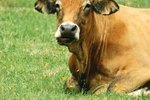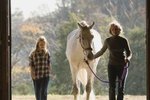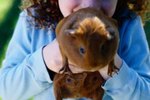
The five types of cattle mange are caused by a variety of mites, some of which burrow into the skin of cattle at different points of the body and cause lesions and sickness, and some of which remain on the surface and cause many of the same problems. These mites are microscopic, so determining their presence is a matter of recognizing the symptoms and treating accordingly.
Surface Symptoms
Mange takes several forms, almost always involving lesions that form on the skin. While sarcoptic mange, caused by a bovine variant of Sarcoptes scabiei, starts on the head neck and shoulders, psoroptic mange, caused by Psoroptes ovis, first appears on the shoulders and rump. Infected areas can eventually include almost any part of the body. The lesions thicken, grow folds, become scabby and begin to leak fluid.
Deeper Problems
Cattle with mange have more than skin issues. They also begin to lose weight and may suffer reproductive effects including poor performance. Cattle infected with mange can suffer decreased daily weight gain, and milk cows may be unable to produce effectively. Cattle may also begin to rub themselves against the sides of buildings or fences, which can cause property damage and can rub themselves so hard that they begin to bleed.
Response to Mange
If you suspect cattle have mange, isolate them from the rest of the herd and keep them under observation until symptoms are obvious. Depending on the type of mange, veterinarians can prescribe various medications, if necessary. For milder infections, pour-on medications often do the trick and work the fastest. More severe cases often necessitate injections that will penetrate down to infections deep under the skin. Discuss the problem with your veterinarian to come up with the best treatment plan.
Preventative Measures
The best way to treat mange is to keep your cattle from getting it. If one cow exhibits the symptoms, immediately remove her from the company of others, as it is a very communicable infection. Always disinfect grooming tools after using them on infected cattle, and clean out stalls in which cattle with mange have been housed before allowing others in. Other preventative measures include avoiding overcrowding, keeping cattle clean and well-fed, and giving them plenty of water.
References
Photo Credits
-
Jupiterimages/BananaStock/Getty Images
Writer Bio
Sarah Moore has been a writer, editor and blogger since 2006. She holds a master's degree in journalism.




